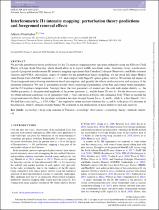| dc.description.abstract | We provide perturbation theory predictions for the H I intensity mapping power spectrum multipoles using the Effective Field
Theory of Large Scale Structure, which should allow us to exploit mildly non-linear scales. Assuming survey specifications
typical of proposed interferometric H I intensity mapping experiments like Canadian Hydrogen Observatory and Radio transient
Detector and PUMA, and realistic ranges of validity for the perturbation theory modelling, we run mock full shape Markov
chain Monte Carlo (MCMC) analyses at z = 0.5, and compare with Stage-IV optical galaxy surveys. We include the impact of
21cm foreground removal using simulations-based prescriptions, and quantify the effects on the precision and accuracy of the
parameter estimation. We vary 11 parameters in total: three cosmological parameters, seven bias and counter terms parameters,
and the H I brightness temperature. Amongst them, the four parameters of interest are: the cold dark matter density, ωc, the
Hubble parameter, h, the primordial amplitude of the power spectrum, As, and the linear H I bias, b1. For the best-case scenario,
we obtain unbiased constraints on all parameters with < 3 per cent errors at 68 per cent confidence level. When we include the
foreground removal effects, the parameter estimation becomes strongly biased for ωc, h, and b1, while As is less biased (<2σ).
We find that scale cuts kmin ≥ 0.03 h Mpc−1 are required to return accurate estimates for ωc and h, at the price of a decrease in
the precision, while b1 remains strongly biased. We comment on the implications of these results for real data analyses. | en_US |

